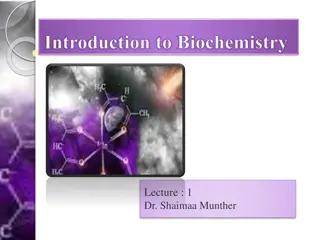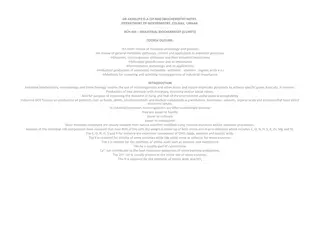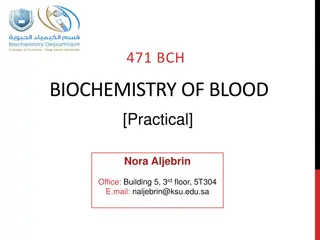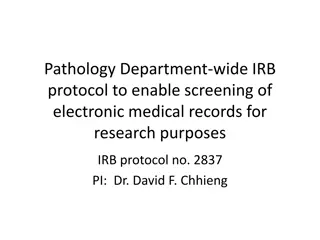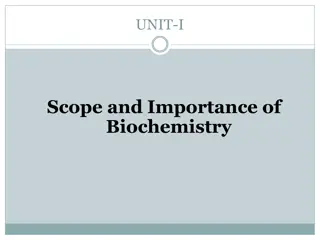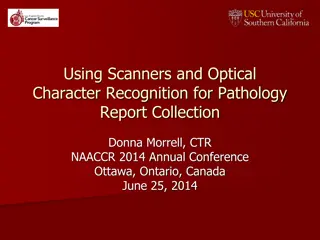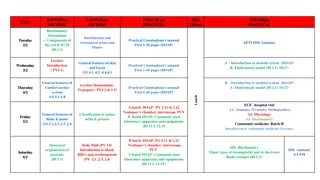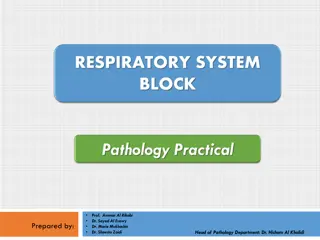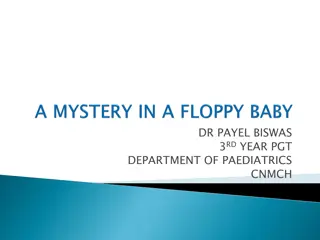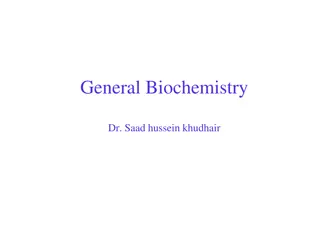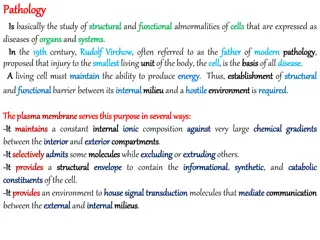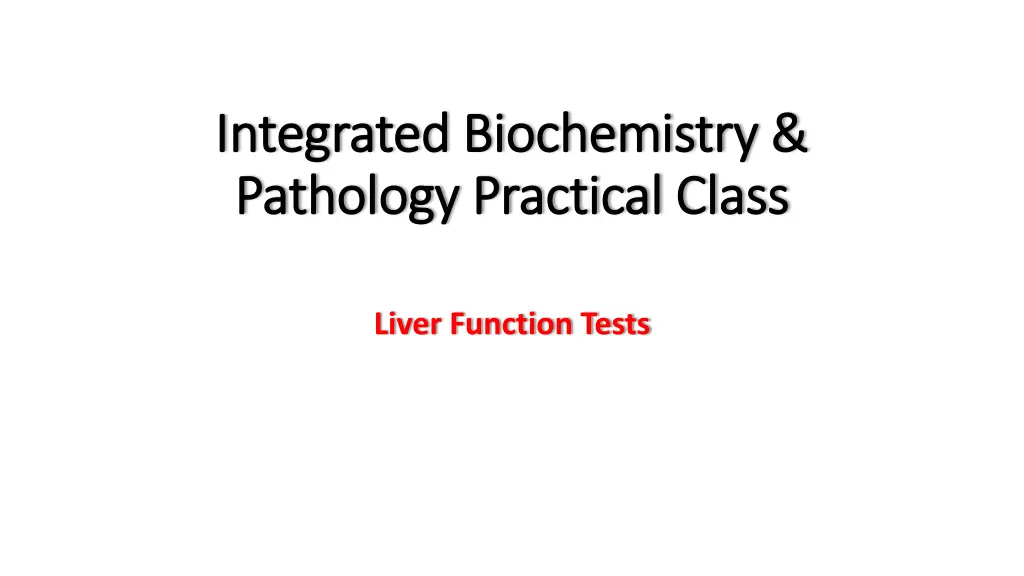
Interpretation of Liver Function Tests in Different Types of Jaundice
Learn to interpret liver function tests in cases of jaundice, including pre-hepatic and hepatic jaundice. Understand the underlying mechanisms and causes of jaundice induced by various factors such as G6PD deficiency and viral hepatitis. Explore the significance of enzyme levels and complete blood tests in diagnosing specific types of jaundice.
Uploaded on | 2 Views
Download Presentation

Please find below an Image/Link to download the presentation.
The content on the website is provided AS IS for your information and personal use only. It may not be sold, licensed, or shared on other websites without obtaining consent from the author. If you encounter any issues during the download, it is possible that the publisher has removed the file from their server.
You are allowed to download the files provided on this website for personal or commercial use, subject to the condition that they are used lawfully. All files are the property of their respective owners.
The content on the website is provided AS IS for your information and personal use only. It may not be sold, licensed, or shared on other websites without obtaining consent from the author.
E N D
Presentation Transcript
Integrated Biochemistry & Integrated Biochemistry & Pathology Practical Class Pathology Practical Class Liver Function Tests
Enzyme Hepatic Jaundice Obstructive Jaundice Slightly raised Hemolytic Jaundice Normal ALT Markedly increased (mainly in liver, cytoplasmic) AST (liver, myocardium and other tissue, cytoplasmic and mitochondrial) ALP (liver, bone and other tissue, result of more synthesis) Markedly increased Slightly raised Normal Raised Markedly increased Normal GGT Increased(Very high in Alcoholic Hepatitis) Markedly increased Normal (in liver and other tissue, microsomal enzyme)
Case Case 1: 1: jaundice) jaundice) Pre hepatic jaundice (Hemolytic Pre hepatic jaundice (Hemolytic Q1. In the light of his medical history, interpret the results of his complete blood tests and liver function tests. Complete Blood tests show only decreased hemoglobin due to hemolysis induced by chloroquine in Glucose-6-phosphate dehydrogenase (G6PD) deficient patient. LFT: Only increased serum bilirubin (unconjugated) because the increased breakdown of hemoglobin exceeds the capacity of liver cells to conjugate bilirubin.
Case Case 1: 1: jaundice) jaundice) Pre hepatic jaundice (Hemolytic Pre hepatic jaundice (Hemolytic Q2. What are the most likely causes (hypotheses) Pre hepatic jaundice (Hemolytic jaundice) induced by chloroquine in Glucose-6-phosphate dehydrogenase (G6PD) deficient patient.
Case Case 1: 1: jaundice) jaundice) Pre hepatic jaundice (Hemolytic Pre hepatic jaundice (Hemolytic Q3. What are the underlying mechanisms for his jaundice? Chloroquine destroys RBCs in G6PD deficient patient leading to increased breakdown of hemoglobin exceeding the capacity of liver cells to conjugate bilirubin.
Case 2 Case 2 Hepatic jaundice (Viral hepatitis) Hepatic jaundice (Viral hepatitis) Q1. In the light of his medical history, interpret the results of his complete blood tests and liver function tests. Complete blood tests show only decreased White blood cell count due to viral infection. LFT: ALT and AST are markedly increased. ALP is elevated (much higher levels in obstructive jaundice). PT is slightly increased due to low prothrombin synthesis by liver cells. Bilirubin in urine increased because conjugated bilirubin is water soluble & can pass through glomerular filter in kidney.
Case 2 Case 2 Hepatic jaundice (Viral hepatitis) Hepatic jaundice (Viral hepatitis) Q2. What are the most likely causes Hepatic jaundice (Viral hepatitis).
Case 2 Case 2 Hepatic jaundice (Viral hepatitis) Hepatic jaundice (Viral hepatitis) Q3. What are the underlying mechanisms for his jaundice? Viral Diseases of liver parenchymal cells decrease its capacity to conjugate bilirubin leading to increased unconjugated bilirubin in blood. Damage to liver cells affects Enterohepatic circulation & increased leaking of conjugated & unconjugated bilirubin into blood. Bilirubin in urine increased because conjugated bilirubin is water soluble & can pass through glomerular filter in kidney.
Case 3 Case 3 Obstructive jaundice Obstructive jaundice Q1. In the light of his medical history, interpret the results of his complete blood tests and liver function tests. Complete blood tests: Haemoglobin is decreased due to malnutrition or low intake (cancer). LFT: Serum bilirubin is increased (conjugated). AST and ALT are slightly increased. ALP and GGT are markedly increased (obstructive jaundice). Serum albumin is decreased because of malnutrition or low food intake (cancer).
Case 3 Case 3 Obstructive jaundice Obstructive jaundice Q2. What are the most likely causes (hypotheses) Obstructive jaundice due to pancreatic carcinoma.
Case 3 Case 3 Obstructive jaundice Obstructive jaundice Q3. What are the underlying mechanisms for his jaundice? Pancreatic carcinoma obstruct the flow of bile leading to increased conjugated bilirubin.
Case 4 Case 4 Drug toxicity Drug toxicity Q1. In the light of his medical history, interpret the results of her complete blood tests and liver function tests. Complete blood tests: Normal. LFT: Serum bilirubin is increased (conjugated and unconjugated). AST and ALT are slightly increased. ALP and GGT are slightly increased. Prothrombin time is increased due to low prothrombin synthesis by liver cells.
Case 4 Case 4 Drug toxicity Drug toxicity Q2. What are the most likely causes (hypotheses) Paracetamol Drug toxicity.
Case 4 Case 4 Drug toxicity Drug toxicity Q3. What are the underlying mechanisms for her jaundice? Depletion of reduced glutathione (GSH) makes the hepatocytes more susceptible to cell death caused by reactive oxygen species. Diseases of liver parenchymal cells decrease its capacity to conjugate bilirubin leading to increased unconjugated bilirubin in blood. Damage to liver cells affects Enterohepatic circulation & increased leaking of conjugated & unconjugated bilirubin into blood.

